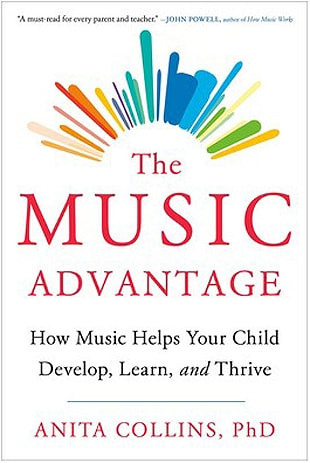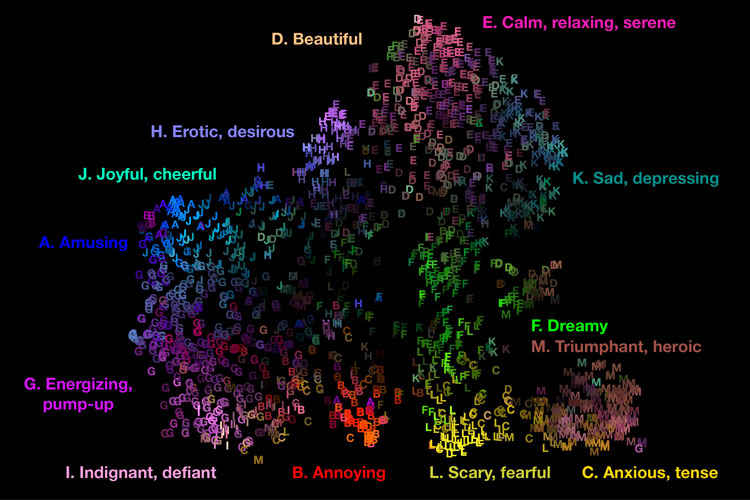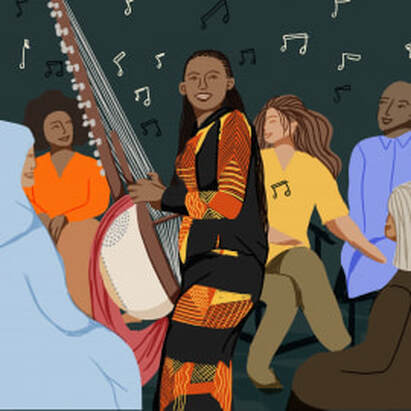- Home
- Process Worldview
- Community
- Art and Music
- Whitehead and Process Thinking
- Podcasts
- Spirituality
- Ecological Civilization
- Education
- Contact
- Social Justice
- Science
- Animals
- Sacred Poems
- Whitehead Videos
- Index of All Titles
- Practicing Process Thought
- Process Spirituality: A Spiritual Alphabet
- Recent Posts
How Music Saves Us
What does music save us from? It saves us from what Buddhists call the three poisons: greed, hatred, and confusion. It also saves us from the pain and sadness that too often accompany life. Buddhists call it dis-ease or dukkha. Music saves us from too much dukkha.
And what does it save us for? Not necessarily for eternal life, although that is a possibility. It saves us for whatever wisdom, compassion, and creativity we can enjoy in this life in the moment at hand, relative to our circumstances and the needs of the world. See "What is the purpose of life? Wisdom, Compassion, and Creativity."
Music never saves us alone. It saves us with help from healthy social relations, rituals for listening while alone or with others, bodily movement such as clapping and dancing, and a host of other factors. Music can well be understood as an evolutionary adaptation to environmental conditions or a by-product of those adaptations, albeit not in ways that are entirely unique. Other animals, too, have their music. In any case, music saves us in these ways:
And what does it save us for? Not necessarily for eternal life, although that is a possibility. It saves us for whatever wisdom, compassion, and creativity we can enjoy in this life in the moment at hand, relative to our circumstances and the needs of the world. See "What is the purpose of life? Wisdom, Compassion, and Creativity."
Music never saves us alone. It saves us with help from healthy social relations, rituals for listening while alone or with others, bodily movement such as clapping and dancing, and a host of other factors. Music can well be understood as an evolutionary adaptation to environmental conditions or a by-product of those adaptations, albeit not in ways that are entirely unique. Other animals, too, have their music. In any case, music saves us in these ways:
- Music saves us by helping children develop, learn, and thrive.
- Music saves us as we age, by providing pleasant memories of music from our youth.
- Music saves us helping friends with dementia and Parkinson’s.
- Music saves us by forming bridges across cultures.
- Music saves us by stimulating creativity and imagination.
- Music save us by soothing us when we really need it.
- Music saves us by helping us connect with our emotions.
- Music saves by helping us know what others feel, too.
- Music saves us by making our brains happy (producing dopamine),
- Music saves us by giving us a sense of identity and meaning.
- Music saves us by strengthening social bonds (for compassionate community.)
- Music saves by giving us something to talk about with friends.
- Music saves us by giving scientists something to do research on.
- Music saves by eliciting mystical experiences.
- Music saves by offering an auditory window to God even if we're not mystical.
You might think that only the last reason is spiritual or religious. The word "God" is used only in #15.
But from the perspective of open and relational (process) theology, God is found in all of these ways. God is the healing and whole-making energy of the universe: the cosmic Lure toward life's fulness. This lure toward life's fulness takes many forms: a lure toward truth and beauty, toward goodness and vitality, health and love. This means that God works through music in all the ways just mentioned. And it means that people who may not believe in God in a formal way, but who believe in the healing and whole-making power of music, may believe in God without believing in "God." Their name for God may be Music. The good news is that, today, scientists are joining joining music-lovers in understanding how music works in human life. If you are new to the science of music, a very good place to start is the Greater Good Magazine: Science Based Insights for a Meangful Life. The links below offer a sample:
But from the perspective of open and relational (process) theology, God is found in all of these ways. God is the healing and whole-making energy of the universe: the cosmic Lure toward life's fulness. This lure toward life's fulness takes many forms: a lure toward truth and beauty, toward goodness and vitality, health and love. This means that God works through music in all the ways just mentioned. And it means that people who may not believe in God in a formal way, but who believe in the healing and whole-making power of music, may believe in God without believing in "God." Their name for God may be Music. The good news is that, today, scientists are joining joining music-lovers in understanding how music works in human life. If you are new to the science of music, a very good place to start is the Greater Good Magazine: Science Based Insights for a Meangful Life. The links below offer a sample:
What follows are some excerpts and amplifications of these and other essays, along with a book review of The Music Advantage by Jon Sweeney of Spirituality and Practice.
Music saves us by helping
us connect with our emotions.
How many emotions? Studies at the University of California at Berkeley, and
reported by the Greater Good Magazine, suggest Thirteen.
The “Star-Spangled Banner” stirs pride. Ed Sheeran’s “The Shape of You” sparks joy. And “ooh là là!” best sums up the seductive power of George Michael’s “Careless Whispers.”...UC Berkeley researchers have surveyed more than 2,500 people in the United States and China about their emotional responses to these and thousands of other songs from genres including rock, folk, jazz, classical, marching band, experimental, and heavy metal...The upshot? The subjective experience of music across cultures can be mapped within at least 13 overarching feelings: amusement, joy, eroticism, beauty, relaxation, sadness, dreaminess, triumph, anxiety, scariness, annoyance, defiance, and feeling pumped up....more
“People from different cultures can agree that a song is angry, but can differ on whether that feeling is positive or negative,” said Cowen, noting that positive and negative values, known in psychology parlance as “valence,” are more culture-specific...Across cultures, study participants mostly agreed on general emotional characterizations of musical sounds, such as anger, joy, and annoyance. But their opinions varied on the level of “arousal,” which refers in the study to the degree of calmness or stimulation evoked by a piece of music....more
Music saves us by
strengthening social bonds.
When in service to compassionate community.
When in service to hateful tribalism, it is not saving.

"Think of a favorite lullaby or children’s song passed down through the generations, or of crowds listening to the national anthem at a baseball game. Music is one way of communicating belonging, which may increase your sense of safety and obligation toward your group.
When we discover that someone likes a piece of music that we like, we tend to think better of them—as if musical preference had a deeper meaning than just entertainment. In fact, studies have shown that people affiliate musical taste with holding certain values, and that this assumed connection between music and values influences how much we think we’ll like someone based on their musical tastes.
Music also influences how we think others will get along. In one recent study, participants listened to music or to silence while they watched videotapes in which three people were seen walking either in step or out of step with one another. When asked to rate levels of rapport and sense of unity among the three walkers in both conditions, the participants who listened to music perceived a greater rapport and unity among the walkers than those participants who didn’t listen to music. This suggests that music somehow strengthens our perception of social cohesion among people, perhaps through mistaking our own feelings for those of the people we observe.
Studies find that social cohesion is higher within families and among peer groups when young people listen to music with their family members or peers, respectively. This effect is true even in cultures where interdependence is less valued, pointing to music’s potential to act as “social glue” that binds people together.
Of course, sometimes these effects can backfire. For example, some have argued that music—specifically the music of Wagner in early 20th Century Germany—played a role in Hitler’s propaganda machine, uniting people emotionally for a hideous political agenda. This reveals the degree to which human bonding can sometimes result in exclusion or even aggression toward out-groups—a tendency that we must continually guard against.
In fact, music works a lot like language does—except instead of words and ideas, emotions and intent are communicated. In this way, music, like language, can be passed on from generation to generation, creating a sense of continuity and loyalty to one’s tribe."
- Four Ways Music Strengthens Social Bonds BY JILL SUTTIE | JANUARY 15, 2015
When we discover that someone likes a piece of music that we like, we tend to think better of them—as if musical preference had a deeper meaning than just entertainment. In fact, studies have shown that people affiliate musical taste with holding certain values, and that this assumed connection between music and values influences how much we think we’ll like someone based on their musical tastes.
Music also influences how we think others will get along. In one recent study, participants listened to music or to silence while they watched videotapes in which three people were seen walking either in step or out of step with one another. When asked to rate levels of rapport and sense of unity among the three walkers in both conditions, the participants who listened to music perceived a greater rapport and unity among the walkers than those participants who didn’t listen to music. This suggests that music somehow strengthens our perception of social cohesion among people, perhaps through mistaking our own feelings for those of the people we observe.
Studies find that social cohesion is higher within families and among peer groups when young people listen to music with their family members or peers, respectively. This effect is true even in cultures where interdependence is less valued, pointing to music’s potential to act as “social glue” that binds people together.
Of course, sometimes these effects can backfire. For example, some have argued that music—specifically the music of Wagner in early 20th Century Germany—played a role in Hitler’s propaganda machine, uniting people emotionally for a hideous political agenda. This reveals the degree to which human bonding can sometimes result in exclusion or even aggression toward out-groups—a tendency that we must continually guard against.
In fact, music works a lot like language does—except instead of words and ideas, emotions and intent are communicated. In this way, music, like language, can be passed on from generation to generation, creating a sense of continuity and loyalty to one’s tribe."
- Four Ways Music Strengthens Social Bonds BY JILL SUTTIE | JANUARY 15, 2015
Music saves us by
making our brains happy.
the dopamine factor
Music impacts us in ways that other sounds don’t, and for years now, scientists have been wondering why. Now they are finally beginning to find some answers. Using fMRI technology, they’re discovering why music can inspire such strong feelings and bind us so tightly to other people.
“Music affects deep emotional centers in the brain, “ says Valorie Salimpoor, a neuroscientist at McGill University who studies the brain on music. “A single sound tone is not really pleasurable in itself; but if these sounds are organized over time in some sort of arrangement, it’s amazingly powerful.”
How music makes the brain happy
How powerful? In one of her studies, she and her colleagues hooked up participants to an fMRI machine and recorded their brain activity as they listened to a favorite piece of music. During peak emotional moments in the songs identified by the listeners, dopamine was released in the nucleus accumbens, a structure deep within the older part of our human brain.
“That’s a big deal, because dopamine is released with biological rewards, like eating and sex, for example,” says Salimpoor. “It’s also released with drugs that are very powerful and addictive, like cocaine or amphetamines.”
There’s another part of the brain that seeps dopamine, specifically just before those peak emotional moments in a song: the caudate nucleus, which is involved in the anticipation of pleasure. Presumably, the anticipatory pleasure comes from familiarity with the song—you have a memory of the song you enjoyed in the past embedded in your brain, and you anticipate the high points that are coming. This pairing of anticipation and pleasure is a potent combination, one that suggests we are biologically-driven to listen to music we like.
- BY JILL SUTTIE | JANUARY 12, 2015
Different notes for different folks
Other research on music supports Large’s theories. In one study, neuroscientists introduced different styles of songs to people and monitored brain activity. They found that music impacts many centers of the brain simultaneously; but, somewhat surprisingly, each style of music made its own pattern, with uptempo songs creating one kind of pattern, slower songs creating another, lyrical songs creating another, and so on. Even if people didn’t like the songs or didn’t have a lot of musical expertise, their brains still looked surprisingly similar to the brains of people who did.
- BY JILL SUTTIE | JANUARY 12, 2015
Music save us by helping children
develop, learn, and thrive.
Book Review by Jon M. Sweeney
reposted from Spirituality and Practice

Music grows our brains and develops our capacities to live and love. This is one lesson among many in this interesting book by an educator and researcher into music education and brain development.
The cognitive research in music education is fascinating, and Dr. Collins — a trained classical musician, television presenter, and professor — communicates it very well. For instance, babies hear all sound as music, because they don’t yet understand the meanings of words. Song, singing, and playing music helps infants build trust as they sort out sound meanings in the process of developing talking skills and working with language.
Learning to keep a beat, through clapping or drumming, has been shown to aid children who are struggling with reading.
“The main thing to remember,” Collins writes in chapter 3, “is that your voice is a song inside your toddler’s ears. It is a song filled with information and your toddler is trying to separate out the elements, digest, and process them. Let them sing the same song for days and parrot language sounds until their brain recordings are made. And recognize that you are their rock star and their role model for language.”
In older children and adults, the research shows that music aids productivity. This throws the old parental complaint of “Turn that music off! You’re supposed to be studying!” into fresh perspective. However, the author clarifies: “We know that music and language processing have an overlapping neural network so it seems that listening to music with lyrics while writing words is a confusing activity for the brain.”
Here’s one that may surprise some readers: Playing an instrument teaches adolescents persistence and resilience as well, or better than, participation in sports does.
If you love music, are a parent or a teacher, or simply are interested in cognitive development, we think you will find this book helpful. It is written for the ordinary adult reader, but at the end of each chapter are “Further reading” suggestions that point to university studies and academic articles, for those wishing to delve deeper.
The cognitive research in music education is fascinating, and Dr. Collins — a trained classical musician, television presenter, and professor — communicates it very well. For instance, babies hear all sound as music, because they don’t yet understand the meanings of words. Song, singing, and playing music helps infants build trust as they sort out sound meanings in the process of developing talking skills and working with language.
Learning to keep a beat, through clapping or drumming, has been shown to aid children who are struggling with reading.
“The main thing to remember,” Collins writes in chapter 3, “is that your voice is a song inside your toddler’s ears. It is a song filled with information and your toddler is trying to separate out the elements, digest, and process them. Let them sing the same song for days and parrot language sounds until their brain recordings are made. And recognize that you are their rock star and their role model for language.”
In older children and adults, the research shows that music aids productivity. This throws the old parental complaint of “Turn that music off! You’re supposed to be studying!” into fresh perspective. However, the author clarifies: “We know that music and language processing have an overlapping neural network so it seems that listening to music with lyrics while writing words is a confusing activity for the brain.”
Here’s one that may surprise some readers: Playing an instrument teaches adolescents persistence and resilience as well, or better than, participation in sports does.
If you love music, are a parent or a teacher, or simply are interested in cognitive development, we think you will find this book helpful. It is written for the ordinary adult reader, but at the end of each chapter are “Further reading” suggestions that point to university studies and academic articles, for those wishing to delve deeper.
Excerpt
“You are your baby’s favorite rock star.
“This is a phrase I use often with parents. It started by accident when I was talking to a parent who just didn’t seem to be moved by all the scientific research I was sharing with her. There was something about being her daughter’s first and favorite rock star that set her free from her self-imposed judgment. Maybe there was even a little strut as she walked away from me!
“From an evolutionary perspective, music and singing have a very ancient human history, at least as old as language. Babies understand the world through their ears as rhythm, pitch, contour, and timbre and they use sound to identify the important things, like who are their primary caregivers, who is part of the family or tribes and, possibly most importantly, who they can trust. One of the most effective mechanisms humans have to convey that information is through song.
“Why song? Why not interpretive dance or pictures? The simple answer is that babies need to know who the people around them are as soon as possible. At birth, babies can only see vague shapes, identify faces, some movement, and strong colors. Although identifying different faces is a high priority for babies from birth, they still struggle with facial expressions for the first six months of their lives. Similarly, they can’t move with great control or intention and their smell and taste libraries are only just starting to gather information. But their brains are wired for sound, and the sound of your voice is their favorite station.
“Each voice has a specific auditory signature, a combination of resonances unique to you. Typical babies’ brains have the capacity to process and attribute their significant people’s voices to their role in their lives. This is why on meeting a new adult who speaks to them they may look a little dumbfounded. However, what’s really happening is that the baby’s auditory system is working very hard to answer questions like: 'Who are you?' 'Where do you fit into my world?' 'Can I trust you?' ”
“This is a phrase I use often with parents. It started by accident when I was talking to a parent who just didn’t seem to be moved by all the scientific research I was sharing with her. There was something about being her daughter’s first and favorite rock star that set her free from her self-imposed judgment. Maybe there was even a little strut as she walked away from me!
“From an evolutionary perspective, music and singing have a very ancient human history, at least as old as language. Babies understand the world through their ears as rhythm, pitch, contour, and timbre and they use sound to identify the important things, like who are their primary caregivers, who is part of the family or tribes and, possibly most importantly, who they can trust. One of the most effective mechanisms humans have to convey that information is through song.
“Why song? Why not interpretive dance or pictures? The simple answer is that babies need to know who the people around them are as soon as possible. At birth, babies can only see vague shapes, identify faces, some movement, and strong colors. Although identifying different faces is a high priority for babies from birth, they still struggle with facial expressions for the first six months of their lives. Similarly, they can’t move with great control or intention and their smell and taste libraries are only just starting to gather information. But their brains are wired for sound, and the sound of your voice is their favorite station.
“Each voice has a specific auditory signature, a combination of resonances unique to you. Typical babies’ brains have the capacity to process and attribute their significant people’s voices to their role in their lives. This is why on meeting a new adult who speaks to them they may look a little dumbfounded. However, what’s really happening is that the baby’s auditory system is working very hard to answer questions like: 'Who are you?' 'Where do you fit into my world?' 'Can I trust you?' ”
|
|
|





